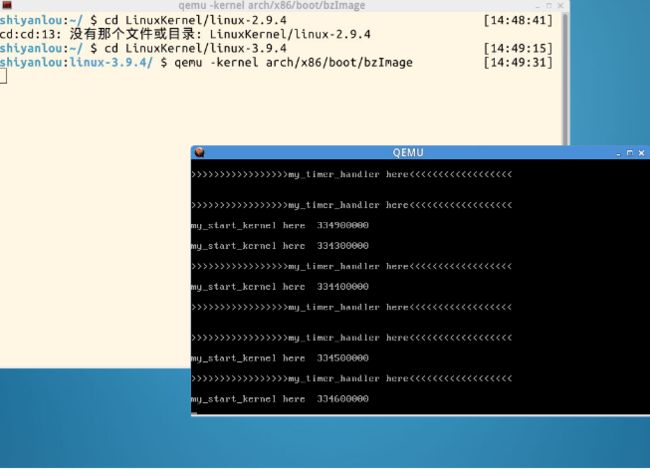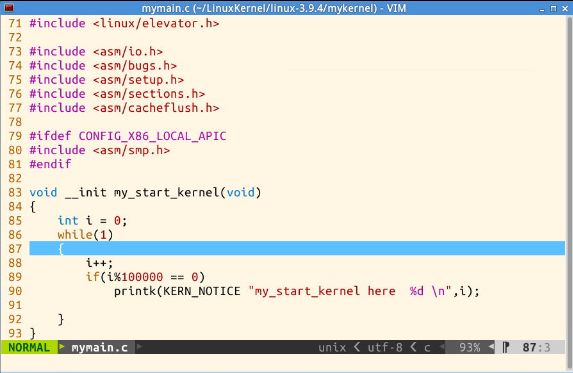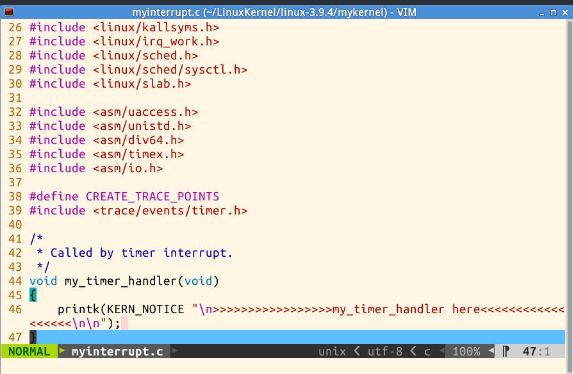Linux内核分析第二周:操作系统是如何工作的
第一讲 函数调用堆栈
- 计算机是如何工作的?
(总结)——三个法宝
1,存储程序计算机工作模型,计算机系统最最基础性的逻辑结构;
2,函数调用堆栈,高级语言得以运行的基础,只有机器语言和汇编语言的时候堆栈机制对于计算机来说并不那么重要,但有了高级语言及函数,堆栈成为了计算机的基础功能; enter
pushl %ebp
movl %esp,%ebp
leave
movl %ebp,%esp
popl %ebp
函数参数传递机制和局部变量存储
3,中断,多道程序操作系统的基点,没有中断机制程序只能从头一直运行结束才有可能开始运行其他程序。
堆栈是c语言程序运行时必须的一个记录调用路径和参数的空间
-函数调用框架
-传递参数
-保存返回地址
-提供局部变量空间
堆栈相关的寄存器
-esp,堆栈指针(stack pinter)
-ebp,基址指针(base pointer)(高地址) 堆栈操作
-push 栈顶地址减少4个字节(32位)
-pop 栈顶地址增加4个字节 ebp在C语言中用作记录当前函数调用基址 其他关键寄存器
-cs:eip:总是指向下一条的指令地址
2.参数传递过程 下面的代码中有参数传递过程:
#include
void p1(char c)
{
printf("%c",c);
}
int p2(int x,int y)//重点关注这里的局部变量
{
return x+y;
}
int main(void)
{
char c ='a';
int x,y; x =1;
y =2;
p1(c);
z = p2(x,y);//重点关注这里的参数传递过程
printf("%d = %d+%d",z,x,y);
}
第二讲 借助Linux内核部分源代码模拟存储程序计算机工作模型及时钟中断
mykernel实验指导(操作系统是如何工作的)
使用实验楼的虚拟机打开shell
cd LinuxKernel/linux-3.9.4
qemu -kernel arch/x86/boot/bzImage
然后cd mykernel 您可以看到qemu窗口输出的内容的代码mymain.c和myinterrupt.c
使用自己的Linux系统环境搭建过程参见mykernel,其中也可以找到一个简单的时间片轮转多道程序内核代码
2.一个简单的操作系统内核源代码
1.mypcb.h//头文件
10 #define MAX_TASK_NUM 4
11 #define KERNEL_STACK_SIZE 1024*8
12
13 /* CPU-specific state of this task */
14 struct Thread {
15 unsigned long ip;
16 unsigned long sp;
17 };
18
19 typedef struct PCB{
20 int pid;
21 volatile long state; /* -1 unrunnable, 0 runnable, >0 stopped /
22 char stack[KERNEL_STACK_SIZE];
23 / CPU-specific state of this task /
24 struct Thread thread;
25 unsigned long task_entry;
26 struct PCB next;
27 }tPCB;
28
29 void my_schedule(void);
2.mymain.c
16 #include "mypcb.h"
17
18 tPCB task[MAX_TASK_NUM];
19 tPCB * my_current_task = NULL;
20 volatile int my_need_sched = 0;
21
22 void my_process(void);
23
24
25 void __init my_start_kernel(void)
26 {
27 int pid = 0;
28 int i;
29 /* Initialize process 0*/
30 task[pid].pid = pid;
31 task[pid].state = 0;
32 task[pid].task_entry = task[pid].thread.ip = (unsigned long)my_process;
33 task[pid].thread.sp = (unsigned long)&task[pid].stack[KERNEL_STACK_SIZE-1];
34 task[pid].next = &task[pid];
35 /fork more process /
36 for(i=1;i<MAX_TASK_NUM;i++)
37 {
38 memcpy(&task[i],&task[0],sizeof(tPCB));
39 task[i].pid = i;
40 task[i].state = -1;
41 task[i].thread.sp = (unsigned long)&task[i].stack[KERNEL_STACK_SIZE-1];
42 task[i].next = task[i-1].next;
43 task[i-1].next = &task[i];
44 }
45 /* start process 0 by task[0] /
46 pid = 0;
47 my_current_task = &task[pid];
48 asm volatile(
49 "movl %1,%%esp\n\t" / set task[pid].thread.sp to esp /
50 "pushl %1\n\t" / push ebp /
51 "pushl %0\n\t" / push task[pid].thread.ip /
52 "ret\n\t" / pop task[pid].thread.ip to eip /
53 "popl %%ebp\n\t" //弹出来ebp,内核初始化工作完成
54 :
55 : "c" (task[pid].thread.ip),"d" (task[pid].thread.sp) / input c or d mean %ecx/%edx*/
56 );
57 }
58 void my_process(void)
59 {
60 int i = 0;
61 while(1)
62 {
63 i++;
64 if(i%10000000 == 0)
65 {
66 printk(KERN_NOTICE "this is process %d -\n",my_current_task->pid);
67 if(my_need_sched == 1) //执行10 000 000次才判断一次是否需要调度
68 {
69 my_need_sched = 0;
70 my_schedule();
71 }
72 printk(KERN_NOTICE "this is process %d +\n",my_current_task->pid);
73 }
74 }
75 }
3.myinterrupt.c 调度机制
15 #include "mypcb.h"
16
17 extern tPCB task[MAX_TASK_NUM];
18 extern tPCB * my_current_task;
19 extern volatile int my_need_sched;
20 volatile int time_count = 0;
21
22 /*
23 * Called by timer interrupt.
24 * it runs in the name of current running process,
25 * so it use kernel stack of current running process
26 */
27 void my_timer_handler(void)
28 {
29 #if 1
30 if(time_count%1000 == 0 && my_need_sched != 1)
31 {
32 printk(KERN_NOTICE ">>>my_timer_handler here<<<\n");
33 my_need_sched = 1;
34 }
35 time_count ++ ;
36 #endif
37 return;
38 }
39
40 void my_schedule(void)
41 {
42 tPCB * next;
43 tPCB * prev;
44
45 if(my_current_task == NULL
46 || my_current_task->next == NULL)
47 {
48 return;
49 }
50 printk(KERN_NOTICE ">>>my_schedule<<<\n");
51 /* schedule */
52 next = my_current_task->next;
53 prev = my_current_task;
54 if(next->state == 0)/* -1 unrunnable, 0 runnable, >0 stopped / //在两个正在执行的进程之间做上下文切换
55 {
56 / switch to next process /
57 asm volatile(
58 "pushl %%ebp\n\t" / save ebp /
59 "movl %%esp,%0\n\t" / save esp /
60 "movl %2,%%esp\n\t" / restore esp /
61 "movl $1f,%1\n\t" / save eip / //$1f就是指标号1:的代码在内存中存储的地址
62 "pushl %3\n\t"
63 "ret\n\t" / restore eip /
64 "1:\t" / next process start here */
65 "popl %%ebp\n\t"
66 : "=m" (prev->thread.sp),"=m" (prev->thread.ip)
67 : "m" (next->thread.sp),"m" (next->thread.ip)
68 );
69 my_current_task = next;
70 printk(KERN_NOTICE ">>>switch %d to %d<<<\n",prev->pid,next->pid
71 }
72 else
73 {
74 next->state = 0;
75 my_current_task = next;
76 printk(KERN_NOTICE ">>>switch %d to %d<<<\n",prev->pid,next->pid);
77 /* switch to new process /
78 asm volatile(
79 "pushl %%ebp\n\t" / save ebp /
80 "movl %%esp,%0\n\t" / save esp /
81 "movl %2,%%esp\n\t" / restore esp /
82 "movl %2,%%ebp\n\t" / restore ebp /
83 "movl $1f,%1\n\t" / save eip /
84 "pushl %3\n\t"
85 "ret\n\t" / restore eip */
86 : "=m" (prev->thread.sp),"=m" (prev->thread.ip)
87 : "m" (next->thread.sp),"m" (next->thread.ip)
88 );
89 }
90 return;
91 }
实验截图
黄伟业原创作品转载请注明出处《Linux内核分析》MOOC课程http://mooc.study.163.com/course/USTC-1000029000


